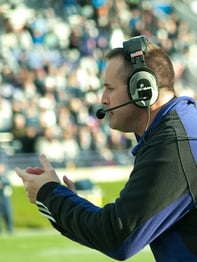Published on
Coaching Practices in Higher Education: Coaching for Performance and Coaching for Growth

Coaching in higher education has been shown to help students succeed in college. However, there is confusion regarding coaching, specifically the distinction between coaching and academic advising. Some campuses have created separate positions for each, while other campuses have combined the two roles. Instead of focusing on the title, we prefer to focus on the coaching’s effect by asking fundamental questions: what is the goal of coaching in higher education? Coaching for performance? Coaching for growth? What are we really trying to accomplish? Understanding the goal of your coaching practice will help to identify the best practices needed to successfully implement coaching on your campus, based on your student population and needs.
We define coaching as someone professionally trained to partner with people by tapping into their full potential, helping them move forward through the process of identifying and achieving personal and professional goals that will maximize their potential (Tony Robbins, https://www.tonyrobbins.com/coaching/results-life-coach/).
Common qualities that an effective coach must utilize:
- Maintaining a positive attitude.
- Being passionate about your desire to help others.
- Having great listening skills.
- Being non-opinionated and non-judgmental.
- Cultivating curiosity and exploration in the process.
- Challenging reality and prospective solutions.
- Observing your students and yourself.
- Communicating with clarity.
- Being honest and trustworthy.
- Being open to learning and growing personally and as a coach.
- Facilitating conversations around growth and change.
- Prioritizing developing and maintaining strong relationships.
- Believing in your students’ resourcefulness.
Coaching in higher education typically has two main goals: (1) to increase student performance on tasks associated with academic achievement, and (2) to develop students’ level of thinking and skills. Coaching practices generally employ the use of powerful questions that prompt reflective thinking. This paper will make a distinction between two main practices in coaching: coaching for performance and coaching for growth.
Coaching for (academic) performance
Most coaching programs in higher education focus on academic performance. Specifically, these practices are centered around institution-based performance goals: achieving higher grade point averages and increasing retention and graduation rates. The goal is for students to improve skills such as time management, note-taking, studying, and test preparation, which will in turn improve their GPA.
Performance coaching helps students give their best at school.
Performance coaching is primarily focused on short-terms goals: “what do you need to do now for you to be successful in this class and/or by the end of the semester?” or “what skills do you need to develop in order to improve your GPA?”
Performance coaching is about “doing better,” specifically at the institution in which the student is enrolled.
Typical skills practiced: time management, note-taking, study skills, test-taking skills, and resisting procrastination.
Coaching for (personal) growth
While not as prevalent as performance coaching, an increasing number of colleges are incorporating practices focused on personal development: increasing levels of self-awareness (strengths, values, motivations, and desires), exploring purpose, examining mindsets, and pursuing meaningful work.
Coaching for growth helps students achieve clarity on how to become the best version of themselves and how to profoundly serve others.
Growth coaching (also referred to as development coaching) is focused both on short- and long-term goals, bridging the gap between the two.
Development coaching is about “becoming better,” attending to process as well as outcomes.
Typical skills practiced: self-awareness skills (strengths, values, motivations, desires), purpose exploration, goal-setting that may or may not be based on developing skills to perform better, but to also gain insight.
Coaching for performance is more common in higher education because it is easier, quicker, and may even require less training. However, we believe that the most effective coaching practices incorporate both approaches–helping students develop necessary academic skills and supporting students in their personal growth and development. We anticipate that institutions will have greater outcomes in relation to GPA and graduation when coaches focus on both performance and growth. However, the caveat is that coaching for performance AND growth is more demanding and time intensive. These factors are problematic but not insurmountable, when caseloads exceed hundreds of students and appointments are limited to 15-30 minutes.
Since there are many different coaching programs that emphasize performance-based and development-based practices, it is critical to know what results you want to achieve with your program. Best advice: “begin with the end in mind.” What do you want your students to understand/leave with because of your coaching program?
To help with this process, start by completing one or both templates below to define the purpose of your coaching program (note: examples are statements based on the Life Design Catalyst Program in the School of Health and Human Sciences at the University of North Carolina at Greensboro):
Template: Our coaching program helps <be specific on who’s it for> solve <their main problem>. They start our program feeling and/or thinking <current mindset> – and when they finish, they will think and feel <new mindset>.
Example: “Our coaching program empowers first-year students to answer the questions, “Who I am I meant to be?” and “What am I here to do?” They start our program feeling lost and confused about their direction, major, and/or career path; when they finish, they feel confident and excited about their academic and career plans.”
Template: Our coaching program will guide them through a process that entails <core main topics>. Each student who completes our program will have (or be able to) <enter tangible outcomes and benefits e.g., path to success, self-confidence, plan for graduation, better grades, inner peace, etc.>.
Example: “Our coaching program guides them through a process that entails purpose exploration, defined as “becoming the best version of yourself in service to something bigger than yourself.” Each student who completes our “HHS125: What Could I Do With My Life” course leaves with academic, career, and life plans that provides hope for a better future.”
Once you have your statement, map out the content of your program. Provide ideas on the specific products and services you will provide for your students, such as blogs, e-books/workbooks, on-line and/or face-to-face courses, and one-on-one and/or small group coaching.
Evaluate your plan by asking: “is our program bringing out the best in our students–personally and professionally?” If you can honestly answer yes, you are on the right path to offering students meaningful and effective coaching approaches for personal, professional, and academic success.
Author Perspective: Educator



